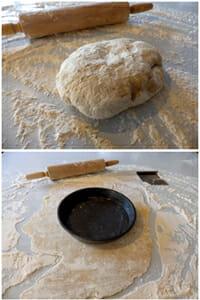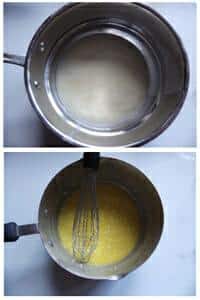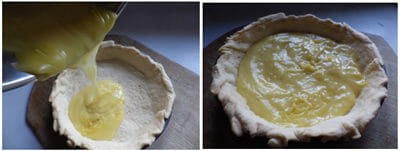Why Our Pioneer Ancestors Loved Vinegar Pie
Many people today wince at the thought of a Vinegar pie. However, our pioneer ancestors loved it and used apple-cider vinegar to take the place of lemon or lime juice to make this tart and sweet pie. The recipe is essentially identical to a Key Lime pie or a Lemon Meringue pie except 3 tablespoons of apple-cider vinegar are substituted for the customary 3 tablespoons of lime juice or lemon juice in traditional citrus pies.
Pioneers knew how to improvise
The simple ways that we buy things like lemons, limes and other citric fruits like oranges seems so easy these days. Our ancestors didn’t have it so easy. Something as simple as a lemon, orange or lime was a rare treat and often very expensive and hard to find. There just wasn’t a good distribution system and the amount of lemons, limes and oranges weren’t as great as today because there wasn’t the demand, let alone the distribution systems. But that didn’t stop many pioneer women from improvising alternative solutions. That’s what motivated the first vinegar pie recipes. The acetic acid in the vinegar delivered the same piquancy and tartness as the citric acid in citrus fruits.
A favorite in logging and mining camps
Every logging or mining camp had a cook shack. This is where the loggers and miners gathered to eat. Much of the menu consisted of wild game and fish and various breads also found their way onto the cook shack tables. But dessert was another story and while cooks in these camps were very creative, the options were often limited. That’s when and why vinegar pie emerged as a camp favorite. It was not only sweet and tart but was often topped with a light and delicate meringue that gave it a creamy and sweet topping.
Apple-cider vinegar to the rescue
Apple-cider vinegar was used in a variety of ways by our pioneer ancestors. It was an antiseptic, used for food processing and canning, a household cleaner, a topical antibiotic for cuts and scrapes, a flavoring ingredient in many recipes like vinegar pie, and oh yeah… sometimes they even used it to make a salad dressing.
Books have been written about the health benefits of apple-cider vinegar and if you want to get a good dose, plus appreciate a bit about our past, give this vinegar pie recipe a try.
The easy way and the hard way to make vinegar pie
Pioneer cooks made everything from scratch and by hand. It’s not that hard to do but it takes time. Today we can take some shortcuts using countertop mixers and buying pie crusts at the store. We’ll cover both approaches if you want to get in touch with our pioneer roots, but we’ll also offer some shortcuts in case you don’t have half a day to make a vinegar pie.
You might want to consider some of the shortcuts because as you’ll see, this recipe takes some time and patience. That’s something that every pioneer needed to bring to everything they did but the result is worth it.
Vinegar Pie recipe and approaches
The foundation of a vinegar pie is the crust. You can make one from scratch or buy a pre-made crust at the store. The important thing is that the pie crust needs to be partially baked before adding the pie ingredients.
By the way, the reason you’re partially baking the crust is because the pie ingredients are wet and warm when they’re added to the crust in the pie pan. If you dump them into a raw pie crust they will dissolve some of the crust and you might end up with a gummy mess.
You also have another option to consider if you want to be 100% authentic. This pie crust recipe calls for butter. This was another scarce ingredient in pioneer times and lard was often used instead. That’s up to you. It curious that finding butter these days is probably easier than finding lard. You could also substitute shortening. Just make sure that any alternative is partially frozen.
Scratch pie crust ingredients:
1 ¼ cups of all-purpose flour
¼ teaspoon of salt
½ cup of semi-frozen butter or lard (you can substitute shortening) and cut into
¼-inch cubes
¼ cup of ice water
Scratch pie crust directions:
Here again, you have two ways to go. The easy way is use a countertop mixer with the batter bread attachment, not the dough hook or the whisk attachment. The hard way is to do it all by hand in a bowl while literally using your hands. And then there’s the easiest way which is buying a ready-made pie crust at the store. It’s up to you.
Scratch pie crust in a counter top mixer
- Add the flour and the salt and run the machine on low for 30 seconds to blend the salt and the flour.
- Slowly begin to drop the chilled chunks of butter, lard or shortening into the bowl. You want to see a crumbly mixture.
- Once you see sufficient crumbs in the mix add a tablespoon of ice water at a time while the machine continues to run at a slow speed. Keep adding the water until you see a dough-like consistency.
- Remove the dough and wrap in plastic wrap and refrigerate for 30 minutes.
- Between two sheets of wax paper roll out the dough until it’s a little larger than the circumference of your pie pan.
- Freeze the pie dough for 5 to 10 minutes. This will make it easier to remove the wax paper.
- Peel off the wax paper and place the dough over the pie pan and press down. You don’t need to butter the pan, the butter or other fats in the dough will be enough.
- Poke about a dozen even placed holes with a fork in the bottom of the dough.
- Preheat the oven to 350 degrees Fahrenheit/176 degrees Celsius and partially bake for 15 minutes. Remove and let it cool in the pan.
The handmade pioneer pie crust as an alternative to a countertop mixer
-
- You need to start with a wide, metal mixing bowl. Add the flour and the salt and stir with a fork until you think it’s blended.
- Add the chilled butter or lard chunks a little at a time and use two forks to break up and blend the chunks with the flour.
- Once you have a crumbly texture, add the ice water a tablespoon at a time and use your very clean hands to mix, squeeze and combine. Keep doing this until you have a dough with the consistency you like.
- Pioneers didn’t have plastic wrap, so they would wrap the pie dough in a piece of cloth and put into the chilliest place in the house or cabin.
- They also didn’t have wax paper, so they would roll out the pie dough on a chilled and floured surface and then carefully lift and roll the dough up onto the rolling pin before transferring to the top of the pie pan and gently unrolling the pin to unwrap the dough.
- They would then repeat the dotting of the fork on the bottom and bake in their wood-burning cookstove until the crust just started to brownlightly and then remove and let cool in the pan.
The Vinegar pie filling
Okay, this is where things get a little complicated. After reading this section you might want to reconsider that store-bought pie crust but that’s your call.
INGREDIENTS:
¼ cup of sifted all-purpose flour
1 cup of white sugar
1 cup of water
3 egg yolks (reserve the egg whites for the meringue)
1/8 teaspoon of salt
1 tablespoon of butter or lard at room temperature
3 tablespoons of apple-cider vinegar
Meringue ingredients
3 egg whites
6 tablespoons of sugar
DIRECTIONS:
-
- Preheat the oven to 325 degrees Fahrenheit or 165 degrees Celsius.
- Mix the flour with a 1/2 cup of sugar. Add the water gradually and cook on top of a double boiler for 15 minutes, stirring constantly.
- In a separate sauce pan combine the remaining 1/2 cup of sugar with the egg yolks and salt and mix well with a whisk until the sugar is dissolved.
- Add this hot flour mixture to the yolk mixture gradually, mixing all the time.
- You want to temper the mix by adding small amounts of hot mixture first, or the eggs will curdle. Return to the double boiler and cook for about 3 minutes more stirring all the time or until the mixture is thick and smooth.
- Shut off the heat but allow the pie mixture to stay warm.
Meringue directions
Once again, we’ll cover this today’s way and the pioneer way.
-
- Add the egg whites and the sugar to a chilled metal bowl, or a chilled metal bowl for a countertop mixer.
- Whisk either in the machine with the whisk attachment, or by hand with a hand-held whisk until the mixture is a light and airy blend with the consistency of a very light whipped cream.
- Add the warm pie filling to the partially baked crust.
- Using a spoon, top the vinegar pie filling with the meringue.When done, touch the top of the meringue with the bottom of the spoon and lift to create delicate curls.
- Bake for 15 minutes or until the meringue is lightly browned.
And there you have it. It’s no different than the steps you take for citrus pies except apple-cider vinegar takes its place. This pie is great with a cup of coffee and a cold slice at night always hits the spot.
###
 Off The Grid News Better Ideas For Off The Grid Living
Off The Grid News Better Ideas For Off The Grid Living










